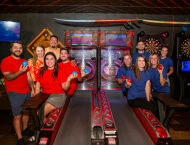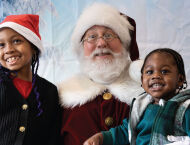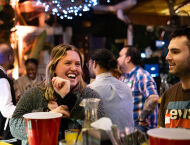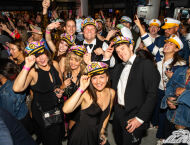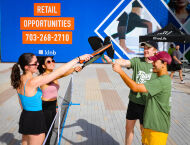Culture
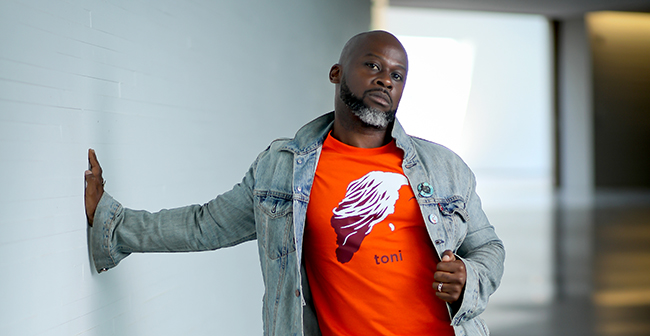 Marc Bamuthi Joseph// Photo: Tony Powell)
Marc Bamuthi Joseph// Photo: Tony Powell)
The Vision of The REACH
August 30, 2019 @ 12:00am
“Listen man, Q-Tip is one of my heroes.”
I’m going to venture an educated guess that the first image that comes to mind when someone mentions the Kennedy Center isn’t a Haitian-American playwright and spoken-word poet choking back tears as he describes what 90s hip-hop group A Tribe Called Quest means to him. And yet, here we are.
I’m sitting next to Marc Bamuthi Joseph, the Kennedy Center’s vice president and artistic director of social impact, in a state-of-the-art, subterranean studio space having a deeply personal conversation about how hip-hop shaped his formative years and how he now gets to work alongside one of his idols for one of the world’s most renowned arts organizations. It is at this exact moment that the driving force behind the Center’s highly anticipated expansion of its campus – The REACH – clicks into place for me.
The three sloping structures opening to the public this month were built upon the pillars of inclusivity, accessibility and interactivity as spaces to facilitate shared artistic experiences for the community. And while the Center’s leadership has invested years of strategic planning and creative thinking behind how to make the spaces as innovative as possible, they ultimately exist as a platform for artists and the community to connect on their own terms.
“We’re inaugurating a way of being in public space,” Joseph says. “People make place. While there’s been an incredible investment in the built capital of these three interconnected pavilions, there has to continue to be investment in the social capital and the social possibility that is made through the creative enterprise.”
Though the Center’s chairman of the board of trustees, David Rubenstein, had a vision for launching The REACH in 2017 to celebrate John F. Kennedy’s 100th birthday, Kennedy Center President Deborah Rutter says she believes the space is opening now because it is the right time to unveil it and share it with the world.
“It’s a time in our society where people crave authentic experiences they can share with others,” she says. “There is a thirst for a sense of community and inclusivity, and The REACH gives us a place for those kinds of experiences.”
Rutter likens The REACH to her own analog version of the Internet.
“I don’t believe that the only way to learn about art is through YouTube or a Google search – no matter how extensive – but rather by experiencing it firsthand. There is no question that the desire to have a shared performance experience is really high, and whatever we can do to promote that is really important.”
The spaces have garnered most of their buzz thus far surrounding The REACH’s opening festival from September 7-22 with nearly 500 events, but Rutter assures that the project will only gain forward momentum with nonstop programming from day one. The REACH will operate as both an education center and public incubator, while offering rehearsal and studio spaces where artists can practice, create, collaborate and perform.
Rutter notes she’s quite proud of the artistic programming behind projects like Studio K’s (the other two studios are Studio J and Studio F, a clever acronym for the space’s namesake) transformation into a cross-genre club and destination for locals to hang out and hear jazz or pop music or spoken word. She also credits the education team for planning curriculum for “maker space” Moonshot Studio (named for “Kennedy’s call for America to think big and travel to the moon”) that’s universally relevant and ties back to programming taking place in the Center’s main hall.
The artistic and education teams behind The REACH are integral to driving its mission forward through immersive programming, and Joseph in particular is invaluable to both sides of the house as he’s uniquely equipped to ride the fine line between artist and administrator.
“To have an artist on staff is so reassuring,” Rutter says. “It’s really helpful because it helps our administrators think about their work through that lens as well. Each of our administrators works with artists in a variety of different ways but to have one as a peer, [and as] somebody who is so enormously articulate to provide the connective tissue between ideas and programming, is invaluable.”
The Center’s president gives a great example in Dear Evan Hansen.While the marketing team is interested in sharing the date and time of the next performance with the public, Joseph is focusing his attention on how the Center can communicate that this work debates and explores difficult emotional ideas of what’s happening with young people today. Both are critical pieces of information, but with very different messaging.
“That piece for me is why it’s so important for the Kennedy Center to do this work around mission, which is to hold a mirror up to our society, to talk about the good, bad and ugly in our everyday lives, and to use art to have greater understanding of who we are,” Rutter continues. “And Marc is the kind of guy who has the capacity to do that on a huge range of topics. He [joins] a team who is so proud and excited to have somebody who can help them take great work to the next level.”
Joseph remains humble during our conversation, saying he doesn’t see a delineation between the two roles – they blur together in everything he does.
“I make culture,” he says. “Some of us, we make dances. Some of us, we make plays. Some of us, we make spreadsheets. But I work with others to make culture. I don’t segment or even bifurcate this notion of administrator and artist. Artists are entrepreneurs and administrators. There isn’t so much of a fixed economy for us.”
He notes that he’s a first-generation American who comes from struggle, and “that never leaves.” In many ways, it’s shaped his professional and creative ideology.
“In terms of my artistic practice and in terms of my administrative practice, there’s a commitment to a kind of equity – a kind of inspired, inclusive and expansive community – that I have to adhere to. What makes sense for me is culture: an inspired, collaborative, expansive, inclusive, loving culture. Anything I can do to make that happen, whether it’s making poems or making programs, I’m gonna do.”
Joseph speaks of a culture of invitation being born through The REACH, where he and his colleagues continue to shine light on culture makers of all stripes. He’s aiming to achieve this in the short-term through the Culture Caucus, a group of 35 artist organizations and individuals handpicked by the Center’s leadership because of their contributions to DC’s broad cultural landscape. He describes them as “community-facing artists-in-residence at work and at play” within The REACH’s walls.
Within the next six months, Joseph and his peers will initiate an impact band of programming to include discussion groups where instead of trying to get people to engage culture on the Center’s terms, they’ll be trying to resource artists whose work amplifies what’s happening in the local community.
“I think that the level of access to culture is different than the level of access to the Kennedy Center and I think that the Kennedy Center – and quite frankly, most arts institutions – have to see themselves as organic citizens within the body politic in a different kind of way,” he says. “It’s a reorientation of the institutional psychology. This is not something that’s just going to happen, but certainly something I’m committed to is recognizing the broad ecosystem of culture makers where they are, resourcing programs where they happen and thinking about the same thing on a national scale.”
He breaks it down for me in simpler terms. Joseph isn’t who you go to for discounted tickets to productions at the Kennedy Center. He’s who you tap when you want to amplify the artistic work being done around the city.
“Resource that and attach commitments of documentation or education or pedagogical support like this. We [as an organization] are a node, but we recognize that there are many, many spokes and many, many stars in this constellation.”
Thinking in broader terms across the nation, Joseph says the next iteration of engagement for arts organizations should be thinking about empowerment, the creative imagination and inspiration as a democratic ideal.
“I’ve been brought in [to The REACH] to infuse the institutional psychology and institutional DNA with a different way of thinking about what is sublime in the arts.”
The sense of openness at the Center lends itself to Joseph’s vision for the future, and Rutter has much to do with it. In the past five years, she’s placed giving DC a seat at the table among more traditional arts & culture hubs like New York and L.A. at the top of her list. Rutter has watched the city experience tangible changes on this front, and although she won’t give herself the credit she most certainly deserves, she along with the leaders of other influential arts institutions has helped break the stereotype of DC as a straight-laced government town. Together, DC’s arts leadership is offering a wave of cultural experiences that are both approachable and accessible to our city’s diverse community.
“I really believe that the DNA of the city has changed in a lot of different ways and that which was already of interest to the people of the city has now been able to be fully embraced,” she says. “If we can demonstrate that really exciting, interesting stuff is happening in Washington, DC and that we are bringing the country together through the arts, then we can change how people think about the importance of arts in our day-to-day life. That’s why it’s really important that as the national cultural center, we invite everybody to be here – from our elected officials to the people who can’t afford to buy tickets to the people who are avid arts lovers.”
While Rutter and Joseph agree that change is gradual, they’re both committed to the baby steps we as a city need to take. In the short-term, they’re both looking forward to this month’s opening festival and the reverberations of the its creative energy. Joseph says the hip-hop block party with headliners De La Soul on September 14 will be “off the chain” but he’s equally amped up about former Wailer (of Bob Marley and The Wailers) Junior Marvin’s DC Lovers Rock on September 22.
“I’m excited about that because love is a thing. Love is not a four-letter word. I want to center love in what it is that we do and how it is that we identify and so doing a reggae-driven ode to love at the close of summer on the river – the romantic in me just loves that.”
Rutter, on the other hand, chooses not to pinpoint just one or two events. Instead, she says she’s most excited about the juxtaposition of different kinds of activities happening simultaneously – a jazz opera going on at the same time as a dance program or taking in a Lichtenstein sculpture and then wandering over to the river pavilion and playing on the brand-new Sing for Hope Piano.
At the end of the day, her goal both for the festival and The REACH as a whole is to invite all of the other cultural organizations in our community and from around the world to share and experience the art being created and explored at the Center’s many spaces. She’s especially looking forward to seeing artists collaborate in-studio and appreciate each other’s work through The REACH’s open spaces.
“I really believe that art and artists hold a mirror up to who we are as a society and if we [act as a] facilitator, we can see into the process and understand why and how that story is being told. That’s the magic that we can do through places like this. We can’t force those new relationships, but we’re excited about creating a space where that can happen.”
Learn more about everything Deborah Rutter, Marc Bamuthi Joseph and the rest of their creative, committed colleagues have in store at The REACH by visiting www.reach.kennedy-center.org.
The REACH at The John F. Kennedy Center for the Performing Arts: 2700 F St. NW, DC; 202-467-4600; www.reach.kennedy-center.org


